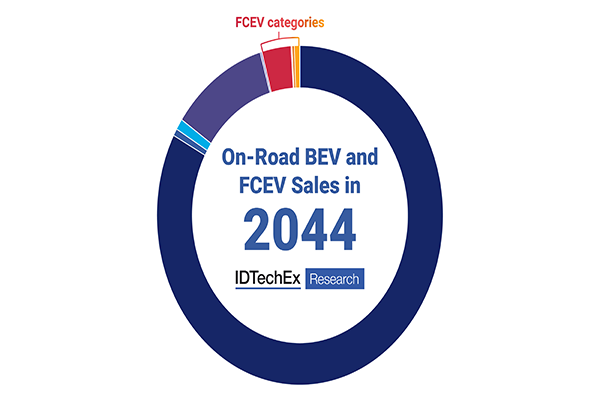Battery electric vehicles (BEVs) have made monumental progress in the passenger car market, becoming a standard drivetrain option. The success in cars is also overflowing into other vehicle segments, such as vans, trucks, buses, 2-wheelers, and more. However, despite some key proponents, fuel cell electric vehicles (FCEVs) have had a much tougher time getting to significant adoption. What are the major barriers, and where can FCEVs still be part of a zero-emission transport network?
IDTechEx’s report on “Fuel Cell Electric Vehicles 2024-2044” examines the FCEV market with historic and current adoption, drivers and barriers, TCO analysis, model benchmarking, and forecasts for units, fuel cell demand, battery demand, and market value across cars, vans, trucks, and buses. IDTechEx predicts that fuel cell electric vehicles will account for just 4% of zero-emission vehicles on the road in 2044, but the opportunity is greater in certain market segments.
Passenger cars
BEV cars had another momentous year in 2023, with IDTechEx predicting over 10 million BEV car sales globally in 2023. In 2022, FCEVs represented only 0.2% of zero-emission car sales, with sales declining slightly from 2021. Despite the benefits of long-range and quick refueling, FCEV cars have not made anywhere near the progress of BEVs.
The largest factors in this struggle have been the lack of hydrogen refueling infrastructure, the cost of hydrogen, and the upfront cost of the vehicles. Any success so far has been bolstered by hefty government and OEM incentives, where the upfront cost of the car is heavily subsidized and, in some cases, the cost of fuel was covered for a period of time.
According to IDTechEx estimates using approximate costs of diesel, electricity, and hydrogen in California in 2023, a Tesla Model 3 could cost around US$0.04/mile to run in comparison to a Toyota Mirai at US$0.21/mile, which is even above a gasoline/petrol car at US$0.15/mile. There will be significant variations in these figures depending on many factors, including the region, but given the greater upfront cost for FCEVs over both combustion engine vehicles and BEVs, an increased running cost makes an FC car a hard sell for consumers. Another major concern is the lack of hydrogen filling stations; as of June 2023, there were approximately 1,100 stations globally. While this is over double what it was in 2019, it is not enough for consumers to be comfortable with refueling.
IDTechEx does expect FCEV car sales to grow in the long term with greater general availability of hydrogen in other applications and a push from governments invested in creating a hydrogen economy, but FCEVs will remain a very small portion of the zero-emission passenger car market.
Light commercial vehicles
The story with light commercial vehicles (LCVs) or vans is similar to the car market’s, but the argument against FCEVs may be even stronger. Total cost of ownership (TCO) is the strongest driver for LCVs; combine this with the fact that typical BEV ranges are sufficient for the vast majority of LCV drive cycles, and the need for the longer range and faster refueling of FCEVs is largely negated. The only use case may be for longer-range deliveries between certain cities, but in large part, this would be catered for by trucks. Therefore, the only growth opportunity for FC LCVs in the near term is in regions with a strong government push for hydrogen economy and on longer-range routes.
Buses
Although there are commercially available FCEV buses, most have been produced as part of pilot programs, with strong support from the government. The upfront cost of FCEV buses is considerably higher than BEV buses and not price competitive with the ICE technology. Whilst FCEV buses are viable, improving, and, sources suggest, could become cost-competitive with BEV buses, the great unanswered issue facing fuel cell technologies is how sufficient ‘Green’ hydrogen can be produced to make them feasible.
Although fuel cell buses are attracting attention, with some countries committing significant investment into developing the needed hydrogen infrastructure, FCEV technology is chasing a moving target, with the BEV buses also improving (batteries, charging infrastructure, and bus timetable schedule optimization). FCEV will find it difficult to catch up. As a result, IDTechEx forecasts a low penetration of FCEV city buses, restricted to a limited number of countries investing heavily in building hydrogen infrastructure and to those bus route schedules that are unfeasible for one BEV bus to operate. There may be greater potential for FCEV in the intercity coach market.
Trucks
When talking about FCEVs, the heavy-duty truck market is usually the one where people see the greatest opportunity. The need to carry very large batteries can limit the overall range and loading capacity of BEV trucks. However, Tesla’s demonstration of a 500-mile delivery with its Semi puts this concern into question. Of the on-road categories, electrification of trucks is possibly at the earliest stage, with electric trucks accounting for less than 1% of the European market in 2022.
The operating costs are still certainly important for trucks. The cost and availability of low-cost green hydrogen is nowhere near where it needs to be for the economical zero-emission operation of an FC truck fleet. Overall efficiency should also be considered, starting from electricity generated from a renewable source; with a BEV truck, ~75% of this energy makes it to the truck’s wheels, whereas for an FC truck, this figure drops to ~25%. Greater adoption of megawatt charging also means that BEV trucks can charge faster during a driver’s break, further limiting the need for longer ranges.
However, there will still be long-haul routes and drive cycles that will still be difficult to achieve with BEVs. Daimler demonstrated a 1000km route with its FC truck in 2023, showing what could be possible. While IDTechEx predicts that BEVs will also be the dominant solution in the zero-emission truck market, there is certainly a greater opportunity for FCEVs here than in other on-road transport segments, with IDTechEx forecasting that FC trucks will be 19% of the zero-emission heavy-duty truck market in 2044.
IDTechEx’s report on “Fuel Cell Electric Vehicles 2024-2044” provides technology and market insights into the adoption of fuel cell electric vehicles for the car, van, truck, and bus market with analysis of drivers, barriers, players, models, and market forecasts for 2024-2044.
Upcoming free-to-attend Webinar
What Opportunities are Left for Fuel Cell Electric Vehicles?
Dr James Edmondson, Principal Technology Analyst at IDTechEx and author of this article, will be presenting a free-to-attend webinar on the topic on Thursday 18 January 2024 – What Opportunities are Left for Fuel Cell Electric Vehicles?
This webinar will cover the market progress, opportunities, and future predictions for FCEVs across several vehicle segments, including:
- Cars
- Light commercial vehicles
- Trucks
- Buses
















